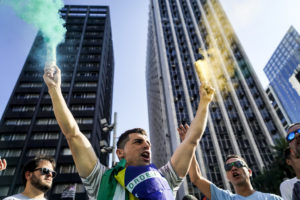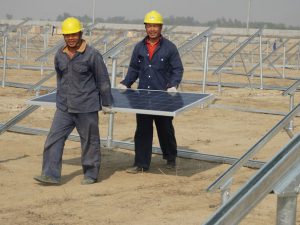The US government is fighting hard this week in Incheon, South Korea. It is fighting with almost all other countries as well as with scientists of the Intergovernmental Panel on Climate Change (IPCC).
Climate negotiators from almost all the 193 countries and European Union that are members of the UN Framework Convention on Climate Change (UNFCCC) are in Incheon this week to hammer out a summary for policymakers (SPM) of a special report that the IPCC has prepared.
Based on around 5,000 papers published in academic journals, the special report is expected to suggest steps national governments need to take to keep average global temperature rise within 1.5 degrees Celsius from preindustrial levels. Its big message: what the world does over the next five years will determine its future.
In closed door sessions, the negotiators are going over every word of the SPM draft. But there is enough information coming out to indicate that US negotiators are trying their best to dilute the SPM as far as possible, seeking to add words like “uncertain” in references to climate change, steadfastly opposing any recommendation to take any action that would require significant sums of money, and repeatedly asking why they should pay for any damage that may affect future generations.
The information indicates that in the first two days of the October 1-5 meeting, Saudi Arabia has been the only vocal supporter of the US.
This US position has been consistent since Donald Trump became the president of the country. He has also decided to pull the US out of the 2015 Paris Climate Agreement. Since then, US government negotiators have tried to block all action to combat climate change, and negotiators from other countries have bent over backwards to accommodate the US.
The negotiations held so far this week indicate that the same is going to happen again, and the SPM will be significantly diluted “to keep the US in the room”, as one European negotiator said.
Standing firm
But scientists are reported to be standing firm, and insisting that they will not dilute the main report.
The penultimate draft of the main report has a stark message: the cost of holding temperature rise within 1.5 degrees Celsius is higher today than it would have been if the decision had been taken when the Paris Agreement was signed in December 2015. That cost is going up all the time, but the cost of inaction is many times higher. The report also lays out the roadmap of what governments need to do to stick to the 1.5 degrees ceiling.
In this report, the IPCC says it is still possible to limit global warming to 1.5 degrees, but it will require a significantly more ambitious and urgent response to climate change than governments around the world are providing now. The report says the fight against climate change is being held back by inadequate policies and outdated economic assumptions.
This special report shows that the next few years are crucial. The world must reduce greenhouse gas emissions drastically by 2030, and reach a net-zero emission scenario by the middle of the century.
Current climate pledges under the Paris Agreement, even if successfully implemented, would mean 3-4 degrees of warming.
The final report and the SPM are scheduled for release on October 8.
Costs of emission
Climate change is already affecting farming worldwide, making droughts, storms and floods more frequent and more severe, and raising the sea level. More disquieting reports keep coming all the time.
After the IPCC finalised its special report, a new study by Katherine Ricke of the University of California San Diego and others has calculated that for India, the economic impact of a tonne of carbon emitted into the atmosphere is USD 90, the highest in the world. The study was published in the Nature Climate Change journal late September. This is due to the economic growth forecast for India, which is already the world’s sixth largest economy. It is also due to India’s hot climate and its anticipated continued dependence on coal to generate electricity.
According to reports, Indian government negotiators at Incheon have been pointing out this week that the country has started a huge renewable energy generation programme and is planning another huge programme for electric vehicles. India is hosting a global renewable energy meet in the same week as the negotiations for the SPM.
The study by Ricke and others says that after India, the US will be the worst affected. Every tonne of carbon it emits will cost the economy USD 50. The authors have also found that China – currently the world’s largest carbon emitter – will take a smaller hit of USD 26 per tonne because of the high speed of its economic growth, which means it will do better by investing to check emissions of greenhouse gases, mainly carbon dioxide.
Impacts of 1.5 plus
With more than 1.5 degrees Celsius of global warming, scientists say Kolkata is likely to have more heatwaves like the one in 2015, which killed dozens. The annual water flow in the Ganga basin may decrease by about 20%, and up to 30% of India’s humid tropical forests would be under threat by climate-induced loss under a four degrees Celsius of warming, according to a World Bank report.
While the Paris Agreement had a 1.5-degree ceiling as an aspirational goal, it set a two-degree ceiling as a hard limit. A recent paper in Nature magazine says that in a two-degree warmer world, around a third of the ice stored in the glaciers of the Himalayas will be lost by the end of this century.
A 2018 report by the World Bank says that if the global average temperature rise is as high as four to six degrees, by 2050 there could be 6.7 million climate migrants in Bangladesh and 35.7 million in all of South Asia.
UNFCCC head Patricia Espinosa has said climate change related economic losses were well over USD 320 billion in 2017.
Every degree of global temperature rise reduces wheat yields by 6%, rice by 3.2%, maize by 7.4%, and soybean by 3.1%. Scientists forecast that agricultural yields will fall rapidly between one and three degrees Celsius of warming. Above three degrees, all crops are affected, and fish species go locally extinct, according to the last assessment report of the IPCC.
A four-degree temperature rise may lead to sea level rise of nearly nine metres over several hundred years as it triggers melting of the Antarctic and Greenland ice sheets. This would inundate all coastal cities around the world, putting at risk 470 to 760 million people who live in these cities, including 145 million people in China alone. India and Bangladesh also have more than 10 million people living in these at-risk parts of these cities.
The 2017 Lancet countdown report by the medical journal says that an additional 125 million people around the world were exposed to heat waves each year from 2000 to 2016 (as compared with 1986-2008), and a record 175 million people were exposed to heat waves in 2015.
New methodology
In this special report, the IPCC has used integrated assessment models to create alternate policy choice roadmaps to keep global temperature rise within 1.5 degrees. That is another reason why the US delegation is attacking this report, calling the method new and untested.
In response, IPCC authors say these models should be seen as a series of guides based on current data sets and existing evidence of decisions made by governments, business and society. They point out that over the last decade or more, climate change and its impacts have progressed faster than models have predicted, not slower.
An observer at the Incheon talks said, “The 1.5 report represents the most cutting-edge global effort from scientists to understand the impact climate change will have on the planet, but many of the changes we are facing are unprecedented – like a complete loss of Arctic sea ice, or crop failures on a huge scale – which makes them difficult to account for in models. This year has seen extreme weather events sweeping the planet with just one degree of warming, and is just a hint of what is to come.”
On the positive side, the transition to renewable energy sources is also progressing faster than economic models have predicted, and their costs continue to move downwards.
Controversial option
In this special report, the IPCC says keeping global temperature rise within 1.5 degrees will be impossible unless the world can find ways to remove greenhouse gases from the atmosphere. One option is carbon dioxide removal via natural solutions like reforestation, or restoring degraded ecosystems. Another option is to use bioenergy combined with carbon capture and storage (BECCS).
The second option is controversial because it is based on a large number of economic assumptions that may or may not hold good. BECCS is essentially a power station designed to produce energy and capture and store the resulting carbon dioxide. If the assumptions do not hold, it can have a big negative impact on land use. Plus, research in this technology is in its infancy. Some scientists say that protecting and regenerating forests is a better option in many places.
The overwhelming majority of scientists and a significant majority of climate negotiators are in favour of taking stronger action now. But with the US continuing to oppose it tooth and nail, the tussle is likely to affect the next annual climate summit, scheduled in Poland this December.
![<p>In a village on the edge of the Sundarbans and facing the Bay of Bengal, Jasimuddin Sarkar in front of his farm that now grows nothing, thanks to sea level rise, and his house that gets flooded with dirty saline water every third or fourth day [image by: Joydeep Gupta]</p>](https://dialogue.earth/content/uploads/2018/10/Farmer_Jasimuddin_Sarkar_Baliara_Mousuni_Joydeep-e1515995272635.jpg)

![women farming on chilli farms in Pakistan [image by: Zofeen T. Ebrahim]](https://dialogue.earth/content/uploads/2018/10/IMG_3660-300x225.jpg)



![Bhutan elections 2018. Bhutanese scrutinise claims on an election board - the only place where political parties are allowed to put promotional material [image courtesy: Kuensel]](https://dialogue.earth/content/uploads/2018/10/election-2018-300x225.jpg)
![Farming the biofuel Jatropha in Morocco [Image: Joydeep Gupta]](https://dialogue.earth/content/uploads/2018/10/Jatropha_Morocco-300x225.jpg)

